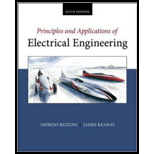
Concept explainers
The so-called forward-bias i-v relationship for a silicon diode is:
where
wherek is Boltzmann’s constant, T is absolute temperature in kelvins, and q is the charge of an electron. Consider the circuit shown in Figure P3.83. KVL applied around the loop results in a transcendental equation for the loop current
a. Use graphical analysis to estimate the current through and the voltage across the diode. Assume
b. Use the iterative algorithm depicted in the flowchart of Figure P3.83 to construct a computer program that solves for V and i. The algorithm relies upon the fact that
Want to see the full answer?
Check out a sample textbook solution
Chapter 3 Solutions
Principles and Applications of Electrical Engineering
- A silicon diode is in parallel with a germanium diode and is connected to a load resistor having a value of 20 k2 and a forward supply voltage of 10 V. What is the approximate voltage across the silicon diode? * 0.7 V 0.3 V 10 V O 1.0 Varrow_forwardConsider the given circuit and a waveform for the input voltage. The diode in circuit has cutin voltage V, = 0. %3D R 10- D1 6 V 8 V D2 -10 is The waveform of output voltage v.arrow_forwardWhat voltage is boosted at the output of a multiplier.Choices: average, rms, peak, or instantaneous Which assumption is not used in the analysis of multipliers?Choices: a capacitor will not discharge, start with the cycle of the source that will forward bias the nearest diode, the output will always be multiplied, or a single diode is forward biased at a time A voltage multiplierChoices: multiplies the output voltage, has very high voltage and low current ,can employ inductors, or may not have equal numbers of diodes and capacitors A voltage regulator maintains constant voltage at the load regardless of variations atChoices: the input and output, the load, source, or in the environment Between a lower percent regulation and a higher one, which is better?Choices: lower or higherarrow_forward
- Find Q-point (I_D, V_D) for the diode circuit shown below by using the diode equation numerically with I_s = 10^-15 A, V_T = 26 mVarrow_forwardIn the circuit shown below, the ideality factorn of the diode is unity and the voltage drop across it is 0.7 V. The dynamic resistance of the diode at room temperature is approximately 1.7 V 31 k2arrow_forwardGiven the following circuit with VDD= 9.2 V, R=2.3 k2, then the current Iis: Use the CVD model for the diode, with VD = 0.65 V. I VDD a. 0.004000 A O b. 3.717391 A OC. 0 A d. 4.000000 A e. 0.003717 A R + VD -arrow_forward
- Two silicon diodes, with a forward voltage drop of 0.7 V, are used in the circuit shown in the figure. The range of input voltage Vi for which the output voltage V0 = Vi is - Vo R D₁ Z -1 V DC( -0.3 V< Vi < 1.3 V O -1.0 V< Vi < 2.0 V -0.3 V< Vi < 2 V O -1.7 V < Vi < 2.7 V .D₂ 2 V Voarrow_forward1. Determine Vpout for the circuit in below and draw Vauts assume the diode is the silicon type. 10 k +10 V-- V. ov R, 100 k IN914 -10 V- 2. What is the output voltage that you would expect to observe across R, circuit of Figure below? Assume that RC is large enough to prevent significant capacitor discharge. +24 V 10 uF RL 10 kn V. ov. IN914 -24 Varrow_forward2. Draw the graph of the voltage across the 10K resistor (calculate the values for the different voltages across the 10K resistor) of the circuit in the figure, knowing that the voltage source V is sinusoidal. And the diodes are siliconarrow_forward
- Find voltage v₁ of the circuit in the Figure, where D is an ideal diode. Rs US + I R₁ VD D RL VLarrow_forward1. Consider the following circuit, and assume all diodes are ideal. Draw the output to for a triangular input that is given below. ~ Vin R 5 KQ www V1 5V ww D1 R1 5 ΚΩ Vin 10 f -10 D2 ww V2 5V R2 5 KQ Voarrow_forwardQuestion 1 3V K V₁ K №₂ 3V 5v 2k 2K 1 All the diodes are ideal V₂ (V) www %= ? Here V₁ and V2₂ are two squaoce wares, and time is follows: the change with (v) 5k as time (s) time (s) vo(t), that is, the output voltage Vo changes as a function. of time. Clearly label the voltage levels and time in stances. Hint: Diode AND gate → min, OR gate max. 2 4 10 12. Draw the output voltage waveform howarrow_forward
 Introductory Circuit Analysis (13th Edition)Electrical EngineeringISBN:9780133923605Author:Robert L. BoylestadPublisher:PEARSON
Introductory Circuit Analysis (13th Edition)Electrical EngineeringISBN:9780133923605Author:Robert L. BoylestadPublisher:PEARSON Delmar's Standard Textbook Of ElectricityElectrical EngineeringISBN:9781337900348Author:Stephen L. HermanPublisher:Cengage Learning
Delmar's Standard Textbook Of ElectricityElectrical EngineeringISBN:9781337900348Author:Stephen L. HermanPublisher:Cengage Learning Programmable Logic ControllersElectrical EngineeringISBN:9780073373843Author:Frank D. PetruzellaPublisher:McGraw-Hill Education
Programmable Logic ControllersElectrical EngineeringISBN:9780073373843Author:Frank D. PetruzellaPublisher:McGraw-Hill Education Fundamentals of Electric CircuitsElectrical EngineeringISBN:9780078028229Author:Charles K Alexander, Matthew SadikuPublisher:McGraw-Hill Education
Fundamentals of Electric CircuitsElectrical EngineeringISBN:9780078028229Author:Charles K Alexander, Matthew SadikuPublisher:McGraw-Hill Education Electric Circuits. (11th Edition)Electrical EngineeringISBN:9780134746968Author:James W. Nilsson, Susan RiedelPublisher:PEARSON
Electric Circuits. (11th Edition)Electrical EngineeringISBN:9780134746968Author:James W. Nilsson, Susan RiedelPublisher:PEARSON Engineering ElectromagneticsElectrical EngineeringISBN:9780078028151Author:Hayt, William H. (william Hart), Jr, BUCK, John A.Publisher:Mcgraw-hill Education,
Engineering ElectromagneticsElectrical EngineeringISBN:9780078028151Author:Hayt, William H. (william Hart), Jr, BUCK, John A.Publisher:Mcgraw-hill Education,





